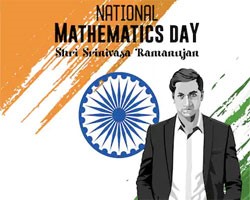SSC Current Affairs
| Important Days |
|---|
|
|
|
Why in the news?
India celebrates National Mathematics Day on December 22, marking the birth anniversary of the great mathematician Srinivasa Ramanujan. Initiated in 2012 by then-Prime Minister Manmohan Singh, the day honours Ramanujan's remarkable contributions to mathematics. National Mathematics Day 2024: Theme The theme for National Mathematics Day 2024 will be “Mathematics: The Bridge to Innovation and Progress." This theme projects that the concepts of mathematics are basic to several other developments in the field of science and technology. It is an effort to inspire and motivate young minds and problem-solving skills among students to understand the beauty of mathematics as a tool for innovation. National Mathematics Day 2024: History It was officially launched by then Prime Minister of India, Dr Manmohan Singh in December 2012, in conjunction with the 125th birth anniversary of S. Ramanujan. This was done in a bid to ensure that the generations to come in India emulate others by endeavouring in mathematics. Ramanujan was born in 1887 and, in his short life span till the age of 32 years, he made outstanding findings in number theory, infinite series and continued fractions. National Mathematics Day 2024: Significance National Mathematics Day is significant as it pays tribute to the contributions of Ramanujan and inspires future generations of mathematicians. The curriculum encourages appreciation of the subject of mathematics beyond mere rote learning, developing an understanding and interest in it. The day is supposed to showcase the role of mathematics in activities forming the core of technology, engineering, economics and health care. Different activities and competitions are held so that, through the means of mathematics, students may develop critical thinking and analyse any problem. Contributions of Srinivasa Ramanujan: Srinivasa Ramanujan made immense, path-breaking contributions to mathematics. These include: Number Theory: The part played in the development of the theory of partition functions and the distribution of prime numbers. His magic number, 1729, is the smallest number that could be expressed as the sum of two cubes in two ways. Infinite Series: He developed an efficient series to calculate π, which finds real application in numerical methods. Mock Theta Functions: These are the functions which were originally discovered by Ramanujan and have great significance in modern modular form theory. Continued Fractions: His work laid foundational principles for computational mathematics. Here are some interesting facts about Srinivasa Ramanujan’s life and career: 📍Srinivasa Ramanujan was born on December 22, 1887, in Erode, Tamil Nadu, to a Brahmin Iyengar family. He became interested in math at a young age and mastered trigonometry by the age of 12. He then became eligible for a scholarship at the Government Arts College in Kumbakonam. 📍Ramanujan studied at the Government College in Kumbakonam, where he failed exams due to his dislike of non-mathematical subjects. 📍He began as a clerk at the Madras Port Trust in 1912, where his mathematical talent caught the attention of colleagues. One referred him to Professor G.H. Hardy at Trinity College, Cambridge. He met Hardy in 1913 and moved to the college. 📍In 1916, Ramanujan received his Bachelor of Science (BSc) degree. With Hardy's help, he published several papers on his subject. The two also collaborated on several joint projects. 📍In 1917, Ramanujan was elected to the London Mathematical Society. The next year, he was elected to the prestigious Royal Society for his work on Elliptic Functions and number theory. He also made history as the first Indian to become a Fellow of Trinity College. 📍Ramanujan returned to India in 1919 and breathed his last on April 26 next year, owing to deteriorating health. He was just 32 years old. 📍An anecdote from the biography ‘The Man Who Knew Infinity’ by Robert Kanigel highlights Ramanujan's brilliance. Hardy travelled on a taxi cab numbered 1729 to visit a sick Ramanujan. During their conversation, Hardy mentioned that it seemed to be a fairly ordinary number. Ramanujan pointed out that it is the smallest number that can be expressed as the sum of two cubes in two different ways (1729=1^3+12^3=9^3+10^3). While it may not be his greatest contribution, it is certainly one of the most memorable. |
| >> More SSC Current Affairs |
